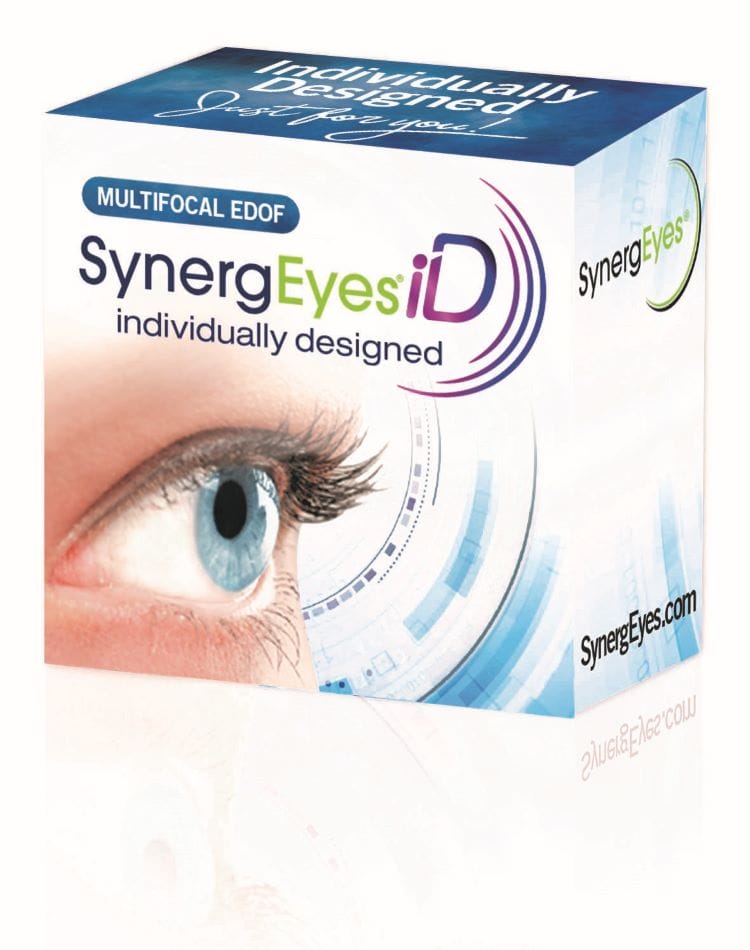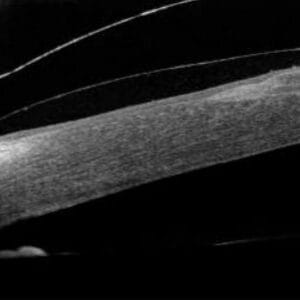June 28, 2023
As we discussed in the article, “Custom Soft Multifocal Contact Lenses Often the Optimal Solution for Presbyopes,” custom contact lens options are a modality in the multifocal contact lens realm that is all too often forgotten. While that article covered how to incorporate soft custom contact lenses into your practice, this article will discuss the lenses available in the gas permeable lens and hybrid category.
Stay with us because we know how hesitant practitioners are to incorporate these lenses. We hear it all the time when we are visiting other offices or from the doctors who refer patients to our practice for specialty lens evaluations. However, we have found that these lenses are the best visual option for a subset of our patient population, and we believe every practice can fit these lenses successfully. We will go through four modalities: hybrid, RGP, scleral, and gentle molding.
Hybrid Contact Lenses
Back in 2014, we incorporated SynergEyes lenses into our practice after a visit to the company headquarters in California. At that visit, one of the other ODs present said that she decided to waive the evaluation fee for an entire month for any patient willing to try a hybrid lens. The results were that about 20% of the patients who tried the lens continued on to wear it. While 20% may not sound like a successful trial, remember that these patients have likely already failed more conventional options, and the successful patients were more than “20/Happy.” They described the lenses in terms we normally do not associate with contact lens wear. None of those patients said the lenses were “fine.” We have seen it first hand in our practice. The descriptors these patients use are “life-changing” and “better vision than I ever thought possible in contacts.”
For presbyopic patients with corneal astigmatism who are not satisfied with vision clarity or stability in soft lenses, this can be a game changer. The hybrid lens consists of a center rigid gas permeable contact lens with a silicone hydrogel skirt. The initial lens can be ordered empirically with keratometry readings, manifest refraction, photopic pupil diameter, and horizontal visible iris diameter (HVID). Fitting sets are available, but we do not use them in our office. The key to best vision in presbyopic hybrid lenses is centration of the lens. Our initial instinct is to adjust the base curve similarly to a traditional RGP lens, but with hybrids, adjustments should be made to the skirt diameter in order to facilitate centration. Fluorescein dye is not necessary to evaluate the fit of the lens, but we do perform corneal staining at the two-week check to see if we need to adjust the base or skirt curve. There is a period of neuroadaptation required with these lenses, and the patient must be willing to try them for 14 days to allow for best visual outcome and comfort.
SynergEyes has three different presbyopic hybrid options: Duette Multifocal, Duette Progressive, and iD EDOF. The Duette Multifocal has a single add power with a center-near progressive design, but you can adjust the size of the add zone (small or large) so fits are straightforward with minimal variables to adjust. The Duette Progressive is available in a center-distance or center-near design. The center-distance design has an adjustable center optic zone from 1.8-4.0mm and adjustable add powers from +0.75D to +5.00D in 0.25D steps. The center-near design has a fixed center optic zone (3.0mm) and three add powers (+1.00D, +1.75D, and +2.50D). Because of the larger number of variables with the Duette Progressive, the practitioner can custom tailor the prescription and fit to each patient depending on their visual needs. For example, patients complaining of halos or blurred night-time driving can benefit from increasing the center-distance zone in their dominant eye. Similarly, patients with high near-visual demand who work with multiple computer monitors at various distances may benefit from a center-near design in their non-dominant or both eyes.
The iD EDOF is SynergEyes’ newest addition to its presbyopic portfolio. It utilizes an Enhanced Depth of Field optic design that is aimed at reducing dysphotopsias such as halos, glare, and ghosting. It comes in a low, medium, and high add, and it does not require adjustments to the optic zone. Its skirt design is also different from the Duette as it fits tangentially to the sclera, mimicking the sclera’s linear shape, which helps optimize centration, movement, and comfort. With all of these options, hybrid contacts are often a good go-to specialty lens.
Rigid Gas Permeable Multifocal Contacts
Our patients seem more shocked to hear that presbyopic rigid gas permeable lenses exist than hearing about soft contact lens options. The options seem greater to the patient than those in soft lenses because of the customizable parameters. Spherical, back toric, front toric, bi-toric, bifocal, and multifocal designs are all available. Each specialty lens manufacturer has several different design options, so we recommend that practitioners new to these lenses become familiar with the options from one or two companies. We will reach for a presbyopic RGP for patients who: 1) have worn single vision RGPs before, 2) have difficulty with insertion and removal of soft, hybrid, or scleral CLs, 3) have too much residual astigmatism with hybrids, or 4) have corneal irregularities that induce higher-order aberrations.
The small diameter RGPs are often much easier to insert and remove than soft lenses, and patients are often surprised at how easy a DMV removal tool is to use. Just like the hybrids above, centration is important to a successful fit, and many variables can be changed or selected such as optic zone, add, center-distance or center-near design, etc. One thing that is different with RGPs compared to hybrids is that toricity (front, back, or bi-toric) can be incorporated depending on the lens and the manufacturer, which can improve vision in patients with residual astigmatism or improve comfort in those with high corneal toricity.
Gone are the days of monovision being the only option for our RGP patients who do not want to wear reading glasses over their contacts. But those are not the only patients who are candidates for this modality of lens. Because of the rigid nature of these lenses, quality of vision is closer to that with spectacle vision than with soft contact lenses. These lenses can also be ordered empirically with keratometry readings, manifest refraction, HVID, and pupil diameter.
Scleral Presbyopic Lenses
As scleral lenses are now back in favor as an option for not only our irregular cornea patients but also for severe dry eye patients, we answer questions regularly about whether the patient has to wear readers over the lenses. There are a few options on the market for presbyopic scleral lenses that can help at intermediate ranges to reduce the need for readers for everything at arm’s length. Sclerals also make a great option for patients who could not adapt to the comfort of hybrids or RGPs. Similar to hybrids, the optic zone size and add power can be adjusted, but toric optics are not usually able to be included with a multifocal design.
Gentle Molding OrthoK
Another modality that is surging again is orthokeratology as we are prescribing it for our pediatric myopic patients in order to prevent progression. A version of these lenses can be a wonderful option for our presbyopic patients as well. Utilizing the gentle molding method of OrthoK allows our myopic or mildly astigmatic patients to see clearly at both distance and near. The goal with these patients is to have a small treatment zone so that the mid-peripheral corneal steepening creates a near zone near the pupil margin. There are even some manufacturers that have options for emmetropic or hyperopic patients that induce central and mid-peripheral steepening that basically creates a center-near optic design on the cornea.
With all of these options, the best way to get started is to reach out to your favorite specialty lens manufacturer(s) and speak to the consultants on staff. They can help with initial lens selection and troubleshooting, and they can even send out loaner fit sets. Evaluation fees for these specialty options should be commensurate with the time and follow-up visits necessary to achieve fit success. Patients should be educated that it may take several trials of lenses over several visits to get the lenses fit correctly and to get the patient seeing the way they want to see. Most patients who end up in one of these options have already struggled with more traditional options and are very willing to spend the time to get the fit and vision dialed in. The reward in the end for both patient and doctor is absolutely worth it.





